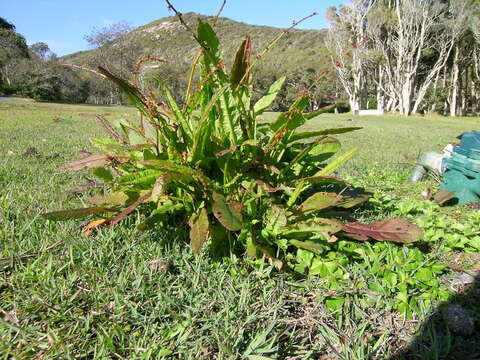Rumex brownii plant2 - Flickr - Macleay Grass Man

Description:
Description: Native, warm-season, perennial, rosette-forming herb when young, later becoming erect, branched and 50-80 cm tall. Leaves are paddle-shaped and up to 12 cm long, often with wavy margins. Flowers are very small and greenish red, occurring in distinctly separate whorls along the spikes. Small triangular fruits have hooked teeth, which allow them to cling to clothes and fur. Flowering is from spring to summer. Found in lawns, pastures and roadsides in full sun or partial shade, but is not restricted to wet areas as the name suggests. Native biodiversity. It may cause oxalate poisoning, but this usually only occurs when starving animals are grazing high densities of the plant. Poisoning is rarely a problem, as plants are usually scattered and large quantities need to be eaten to cause problems. Generally unpalatable, although some landholders report that it is readily eaten in summer. Becomes more abundant with overgrazing, but generally not present in large enough numbers to warrant control. Most effective control is to maintain a healthy vigorous pasture. Slashing is ineffective. Hoeing requires the taproot to be cut off at deeper than 15 cm below ground level. A number of herbicides are registered for control. Date: 23 July 2006, 02:42. Source: Rumex brownii plant2. Author: Harry Rose from Dungog, Australia. Camera location 30° 53′ 16.02″ S, 153° 04′ 26.1″ E : View all coordinates using: OpenStreetMap - Google Earth: -30.887784; 153.073916.
Included On The Following Pages:
- Life (creatures)
- Cellular (cellular organisms)
- Eukaryota (eukaryotes)
- Archaeplastida (plants)
- Chloroplastida (green plants)
- Streptophyta
- Embryophytes
- Tracheophyta (ferns)
- Spermatophytes (seed plants)
- Angiosperms (Dicotyledons)
- Eudicots
- Superasterids
- Caryophyllales
- Polygonaceae (knotweed family)
- Rumex (Docks)
- Rumex pulcher (Fiddle Dock)
- Rumex pulcher pulcher (Browne's dock)
This image is not featured in any collections.
Source Information
- license
- cc-by-3.0
- copyright
- Harry Rose
- creator
- Harry Rose
- source
- Flickr user ID macleaygrassman
- original
- original media file
- visit source
- partner site
- Wikimedia Commons
- ID


